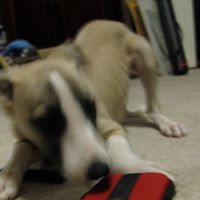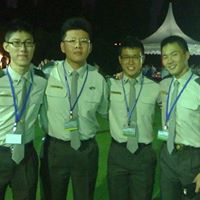Ling Y Yang
age ~39
from East Windsor, NJ
- Also known as:
-
- Lingyao Yang
- Yang Yang
Ling Yang Phones & Addresses
- East Windsor, NJ
- Redwood City, CA
- Stanford, CA
- Ann Arbor, MI
- Winston Salem, NC
Education
-
School / High School:Notre Dame
Languages
English
Ranks
-
Licence:New York - Currently registered
-
Date:2002
Specialities
Dentistry
Medicine Doctors

Dr. Ling Yang, Edison NJ - DMD (Doctor of Dental Medicine)
view sourceSpecialties:
Dentistry
Age:
44
Address:
3900 Park Ave Suite 103, Edison, NJ 08820
7324529292 (Phone)
7324529292 (Phone)
Languages:
English
Name / Title
Company / Classification
Phones & Addresses
HONG KONG RESTAURANT OH, INC
TRUE VAPES INC
Regional Dir
Aeromark International Inc
Ret Misc Merchandise
Ret Misc Merchandise
66 Witherspoon St, Princeton, NJ 08542
174 Nassau St, Princeton, NJ 08542
174 Nassau St, Princeton, NJ 08542
Nueva Vista Investments, LC
Investments
Investments
506 Loch Lomond Ct, Milpitas, CA 95035
Us Patents
-
Distributed On-Chip Decoupling Apparatus And Method Using Package Interconnect
view source -
US Patent:20130320560, Dec 5, 2013
-
Filed:May 28, 2013
-
Appl. No.:13/903323
-
Inventors:Ling Yang - San Jose CA, US
Chanh Tran - San Jose CA, US
Ying Ji - San Jose CA, US -
Assignee:Rambus Inc. - Sunnyvale CA
-
International Classification:H01L 23/48
H01L 21/768 -
US Classification:257774, 438637
-
Abstract:An integrated circuit device is disclosed. The integrated circuit device includes a semiconductor die fabricated by a front-end semiconductor process and having oppositely disposed planar surfaces. The semiconductor die is formed with semiconductor devices, power supply circuitry coupled to the semiconductor devices, decoupling capacitance circuitry, and through-vias. The through-vias include a first group of vias coupled to the power supply circuitry and a second group of vias coupled to the decoupling capacitance circuitry. Conductors are formed in a first metal layer disposed on the semiconductor die in accordance with a back-end semiconductor process. The conductors are configured to couple to the first and second groups of through-vias to establish conductive paths from the power supply circuitry to the decoupling capacitance circuitry.
-
System And Method For Detecting Errors In Audio Data
view source -
US Patent:20140040674, Feb 6, 2014
-
Filed:Aug 1, 2012
-
Appl. No.:13/564610
-
Inventors:Mark Pereira - Livermore CA, US
Ling Yang - Pleasanton CA, US
Govendra Gupta - Gandhi Nagar Jammu, IN -
International Classification:G06F 11/07
-
US Classification:714 49, 714E11024
-
Abstract:An application programming interface (API) executed by a first processing unit combines audio data samples with error code values generated for those samples. The API then causes a data stream to be opened having sufficient bandwidth to accommodate combined samples made up of audio data samples and corresponding error code values. The combined samples are then transmitted to a decoder and validation unit within a second processing unit that receives the combined data, strips the error code values and validates the audio data based on the error code values. When the error code values indicate that the audio data has been compromised, the second processing unit terminates the output of sound derived from the audio data.
-
System And Method For Detecting Errors In Audio Data
view source -
US Patent:20140040709, Feb 6, 2014
-
Filed:Aug 1, 2012
-
Appl. No.:13/564586
-
Inventors:Mark Pereira - Livermore CA, US
Ling Yang - Pleasanton CA, US
Govendra Gupta - Gandhi Nagar Jammu, IN -
International Classification:H03M 13/09
G06F 11/10 -
US Classification:714807, 714E11032
-
Abstract:An application programming interface (API) executed by a first processing unit combines audio data samples with error code values generated for those samples. The API then causes a data stream to be opened having sufficient bandwidth to accommodate combined samples made up of audio data samples and corresponding error code values. The combined samples are then transmitted to a decoder and validation unit within a second processing unit that receives the combined data, strips the error code values and validates the audio data based on the error code values. When the error code values indicate that the audio data has been compromised, the second processing unit terminates the output of sound derived from the audio data.
-
Stacking-Port Configuration Using Zero-Touch Provisioning
view source -
US Patent:20210211351, Jul 8, 2021
-
Filed:Dec 17, 2020
-
Appl. No.:17/124799
-
Inventors:- Suwanee GA, US
Ling Yang - Pleasanton CA, US
Vignesh Hariharan - Fremont CA, US
Robin S. Wong - Alamo CA, US -
Assignee:ARRIS Enterprises LLC - Suwanee GA
-
International Classification:H04L 12/24
H04L 12/423
H04L 12/935 -
Abstract:An electronic device includes multiple networking devices arranged in a stack. The networking devices may include configurable ports, where a given configurable port in the configurable ports may be configured as a data port or a stacking port. During operation, a networking device in the stack may be designated as a master in the stack. In response, the networking device may provide one or more probe messages to determine a state of the networking devices, where the state includes one or more connections among the networking devices. Then, the networking device may verify that the one or more connections are correct. When the one or more connections are correct, the networking device may define a subset of the configurable ports in the networking devices as stacking ports.
-
Distributed On-Chip Decoupling Apparatus And Method Using Package Interconnect
view source -
US Patent:20170098595, Apr 6, 2017
-
Filed:Oct 3, 2016
-
Appl. No.:15/284295
-
Inventors:- Sunnyvale CA, US
Ling Yang - San Jose CA, US
Chanh Tran - San Jose CA, US
Ying Ji - San Jose CA, US -
International Classification:H01L 23/48
H01L 25/065
H01L 21/768
H01L 23/528 -
Abstract:An integrated circuit device is disclosed. The integrated circuit device includes a semiconductor die fabricated by a front-end semiconductor process and having oppositely disposed planar surfaces. The semiconductor die is formed with semiconductor devices, power supply circuitry coupled to the semiconductor devices, decoupling capacitance circuitry, and through-vias. The through-vias include a first group of vias coupled to the power supply circuitry and a second group of vias coupled to the decoupling capacitance circuitry. Conductors are formed in a first metal layer disposed on the semiconductor die in accordance with a back-end semiconductor process. The conductors are configured to couple to the first and second groups of through-vias to establish conductive paths from the power supply circuitry to the decoupling capacitance circuitry.
-
Distributed On-Chip Decoupling Apparatus And Method Using Package Interconnect
view source -
US Patent:20150221589, Aug 6, 2015
-
Filed:Apr 9, 2015
-
Appl. No.:14/683073
-
Inventors:- Sunnyvale CA, US
Ling Yang - San Jose CA, US
Chanh Tran - San Jose CA, US
Ying Ji - San Jose CA, US -
International Classification:H01L 23/528
H03K 5/1252
H01L 23/48 -
Abstract:An integrated circuit device is disclosed. The integrated circuit device includes a semiconductor die fabricated by a front-end semiconductor process and having oppositely disposed planar surfaces. The semiconductor die is formed with semiconductor devices, power supply circuitry coupled to the semiconductor devices, decoupling capacitance circuitry, and through-vias. The through-vias include a first group of vias coupled to the power supply circuitry and a second group of vias coupled to the decoupling capacitance circuitry. Conductors are formed in a first metal layer disposed on the semiconductor die in accordance with a back-end semiconductor process. The conductors are configured to couple to the first and second groups of through-vias to establish conductive paths from the power supply circuitry to the decoupling capacitance circuitry.
Lawyers & Attorneys

Ling Yang - Lawyer
view sourceAddress:
Barclays Capital Asia Limited
29032775xx (Office)
29032775xx (Office)
Licenses:
New York - Currently registered 2002
Education:
Notre Dame
License Records
Ling Yang
License #:
05133 - Expired
Category:
Accountants
Issued Date:
Dec 20, 2009
Expiration Date:
Jun 30, 2010
Type:
Certified Public Accountant
Classmates

Cambridge Rindge & La...
view sourceGraduates:
Marianne Szulewski (1971-1975),
David Weston (1982-1986),
Ling Yang (1983-1987),
anthony santoro (1975-1979),
Robert Robert grant (1945-1949)
David Weston (1982-1986),
Ling Yang (1983-1987),
anthony santoro (1975-1979),
Robert Robert grant (1945-1949)
Flickr
Plaxo

Ling OU YANG
view sourceProject Manager at KONE
Googleplus

Ling Yang

Ling Yang

Ling Yang

Ling Yang

Ling Yang
Relationship:
Single

Ling Yang

Ling Yang

Ling Yang

Ling Ling Yang
view source
Pei Ling Yang
view source
Ling Yang Yang
view source
Mei Ling Yang
view source
Bao Ling Yang
view source
Ling Yang Chang
view source
Ling Yang Feng
view source
Ling Wen Yang
view sourceYoutube
Get Report for Ling Y Yang from East Windsor, NJ, age ~39













